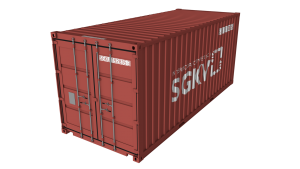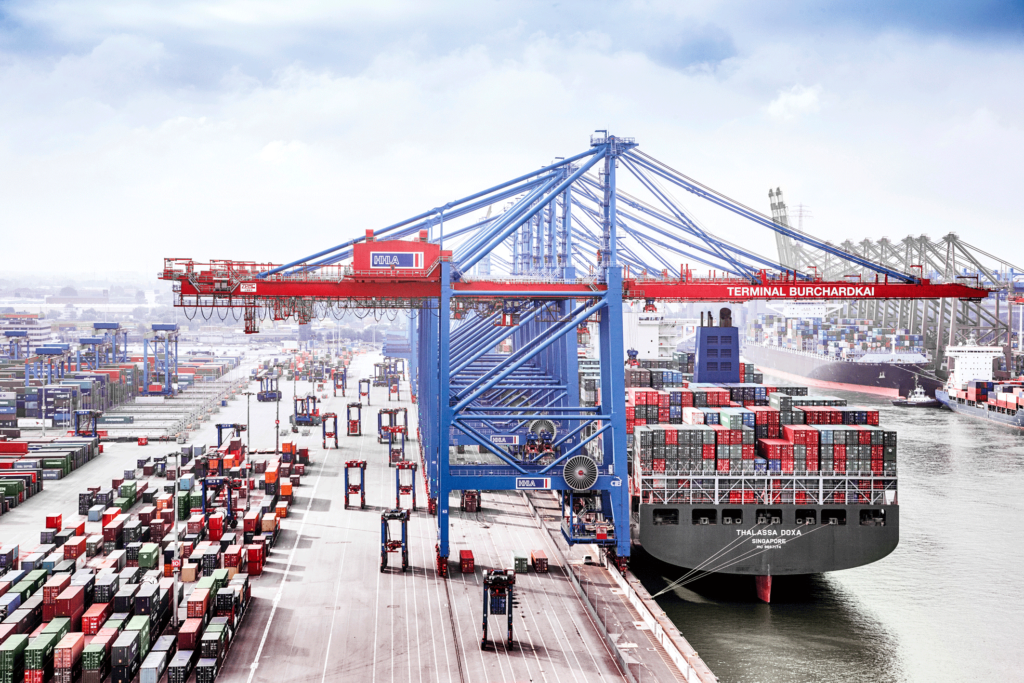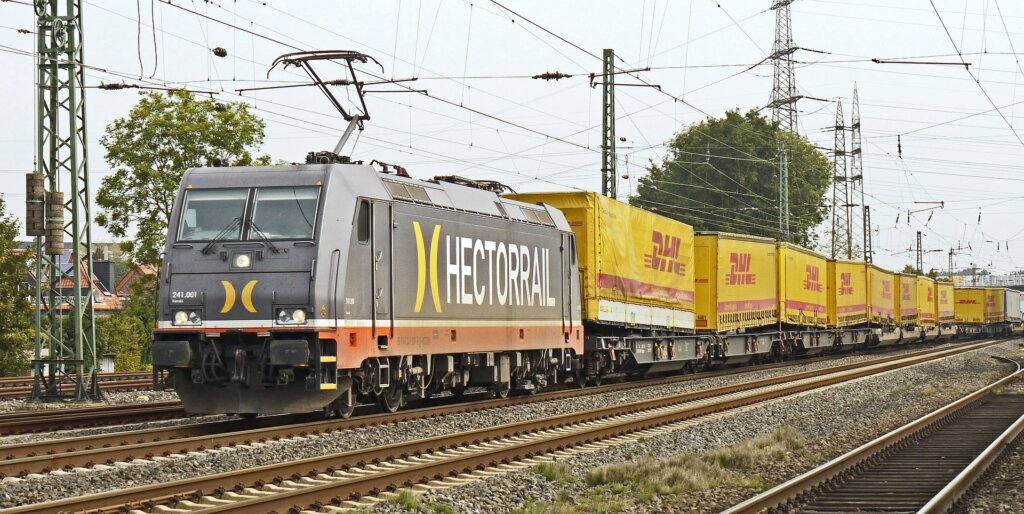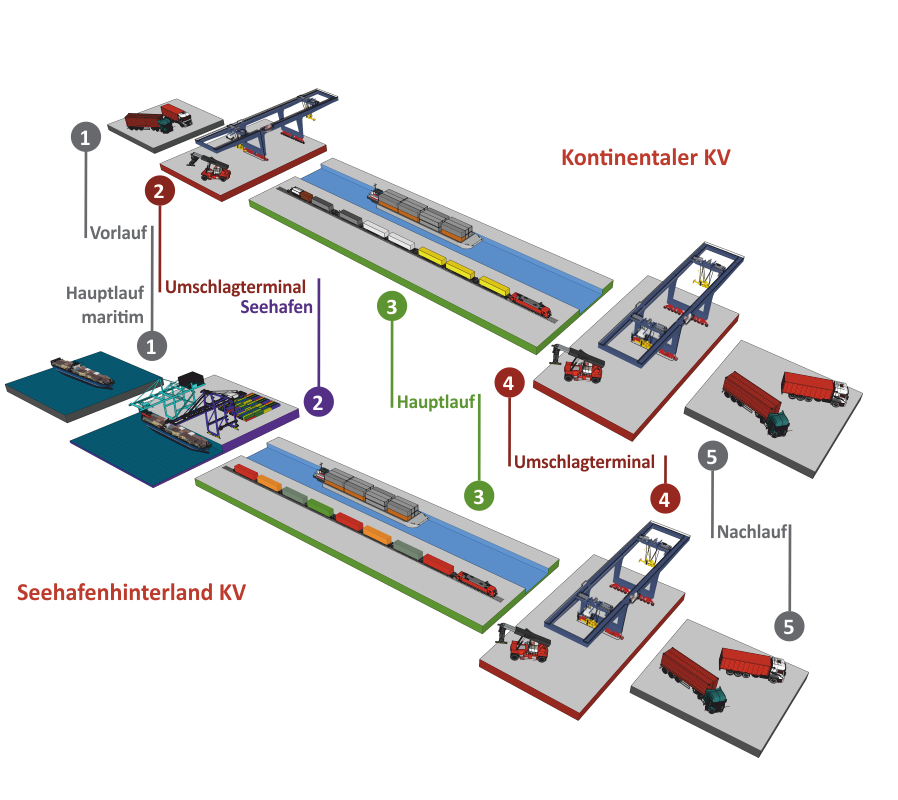Marktsegmente des Kombinierten Verkehrs (en)
General
Combined transport can be divided into two important market segments. Seaport hinterland traffic is traffic between seaports and the hinterland.
In continental traffic, the goods are transported within a continent, i.e. not overseas. In Europe, the goods are transported in a north-south and east-west direction. Continental CT is primarily characterized by the transport of trailers.
Seaport hinterland traffic
The central feature of seaport hinterland traffic is the transport of goods to and from seaports. The competitiveness of this market segment is ensured especially if the seaport terminals are high-performance transport hubs, meaning that both high transshipment capacities as well as large distribution possibilities via rail/waterway exist (cargo bundling). Terminal operators and shipping companies are the key players here. Hamburg and Bremerhaven/Bremen are important hubs in Germany, for example.
By far the most important loading units in this market segment are standardized ISO-containers, accounting for approximately 96% of the overall cargo flow. As mentioned above, seaport hinterland traffic makes up approximately two-thirds of the overall CT market. In 2015, however, rail-bound seaport hinterland traffic declined by approximately 2.3% despite the positive overall economic development noticeable in rail fright in the previous years. Rail-bound seaport hinterland transport is largely oriented towards the national market.
Transported Loading Units

ISO-Container (96%)

Source:Youtube / HHLA
From a geographical point of view, most of the European seaport – hinterland traffic takes place on the north-south axis of Europe. An example of rail-side hinterland traffic is the connection between the seaports of Rotterdam and Genoa on the Rhine-Alpine corridor.
The ports of the Mediterranean and Black Sea als form important interfaces in hinterland traffic on the south-north axis and south-east axis.
Continental Traffic
In Europe, continental CT transports are mainly carried out on north-south and east-west axes. The main leg is predominantly carried out by rail and less frequently by inland waterway.
The competitiveness compared to direct road transport is due in particular to the advantages of so-called swap bodies, which offer convenient options in terms of loading (Euro pallets), handling (craneability, storage facilities) and connection (customers do not need a railway siding). Within the transport chain, swap bodies can be transported in the gateway system (trains connect large terminals). First leg and onward carriage can also be carried out via “antenna trains”.

Loading units that are transported by continental CT include:
- Non-ISO standardized containers (bulk/tank containers, rarely refrigerated containers)
- Swap bodies
- Craneable semi-trailers via short sea
The volume of continental CT accounts for approximately one-third of the overall CT market. In 2015, however, continental CT traffic recorded a major loss of around 9.6%.2
In general, cross-border routes serving bilateral markets represent the main quota for this type of CT (despite the comparably small share of the overall CT market). This applies to both continental and seaport hinterland transport.
Special types of continental traffic
Roll-on Roll-off (RoRo)
Characteristics
- RoRo is a transshipment technology for loading and unloading motor vehicles, railway wagons and intermodal transport units, such as containers, swap bodies / containers and trailers, onto or from a ship.
- Trucks and railway wagons independently drive onto a ship via a loading ramp, intermodal loading units are stowed on the ship by special terminal vehicles.
- RoRo vessels have navigable decks and a hold, as well as bow, side or stern hatches for loading and unloading.
- The RoRo technology is used in accompanied and unaccompanied CT.
- Special types of RoRo-vessels in CT include:
- ConRo-vessel (combined container and RoRo-vessel)
- LoRo-vessel (combined LoLo- and RoRo-vessel)
Advantages
- Short duration of transshipment
- Simple terminal infrastructure
- Flexibility in cargo composition
Disadvantages
- High construction costs of the RoRo-vessels
- Suboptimal utilization of loading space
Practice
- RoRo-vessels are particularly suitable for short- and medium-distance shipping and thus interesting for the Baltic Sea Region.
Rolling Motorway (RoLa)
(from the German term “Rollende Landstraße”)
Characteristics
- Special type of CT.
- RoLa describes the loading of the complete truck, including tractor and loading unit, onto the rail.
- Loading by means of a mobile loading ramp (without additional handling equipment).
- Truck is driven onto the pocket wagons by the driver himself.
- Sequential Loading (one vehicle after the other via mobile ramp).
- RoLa can be regarded as accompanied CT, since in addition to the complete semi-trailer, the truck driver is accompanying the cargo and drives off the head ramp at the train’s destination.
Advantages
- Economic:
- Cost savings (fuel, toll).
- Time saving by avoiding traffic jams and bypassing night and weekend driving bans.
- Driver can comply with statutory rest period without interrupting transport.
- Environmental:
- Reduction of GHG emissions (e.g. CO2) due to transport by rail instead of by road.
Disadvantages
- High personnel costs, as not only the train conducter but also the truck drivers take part in the transport.
- high dead load (weight of the tractor unit), as the cab or tractor apart from the semi-trailer unit is also transported.
Practice
- Only profitable on a few routes, usually over long distances with geographical obstacles (mountains), e.g. in transalpine traffic to / from Austria and Switzerland.
_____________________________________
1vgl. Posset et. al. (2014), Intermodaler Verkehr in Europa
2 SGKV (2016), Facts & Figures

